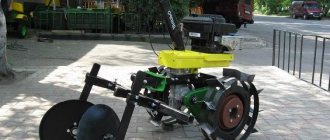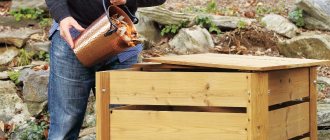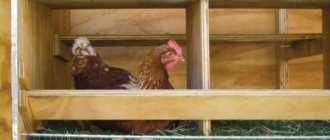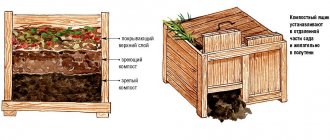I live in a house where grapes have been growing for over 40 years and I don’t know what to do with them (they have seeds, so I don’t eat them very much). I also have a great basement and project room and this year I decided to try making wine. Having tried to make grape jam last year, I realized that using a potato masher is inconvenient and ineffective.
I visited a local winery and asked about the brewing process and basic materials. The store manager said that 50 kg of grapes can make 35-40 liters of wine. From what I remember last year, we took about 7 kilograms of grapes (including stems) and got about 3 liters of juice after 45 minutes of rubbing and squeezing through a cloth. If we want to process all 50 kg, we need a more efficient processing method.
My basic crusher plan was to use a car jack to push a disc into a perforated pot to press the grapes. A little later you will see drawings of what I got and how to make a grape press with your own hands.
Hydraulic grape presses
Hydraulic juicers are used to squeeze juice from grapes and many other berries, fruits and vegetables, such as currants, apples, carrots, etc.
Hydraulic presses are convenient and practical to use; they are manufactured in two main varieties.
Jack press. This equipment has a square or rectangular metal frame equipped with a stop for attaching the jack rod. Moreover, in different designs the jack is installed either in the upper or lower part of the device, strictly in the center of the press.
This equipment is quite easy to operate; both men and women can handle the work of squeezing juice, because during use it is not necessary to exert much physical force.
The principle of operation is as follows: the jack rod extends and presses the pancake, squeezing out the juice from berries or fruits. But there is one problem - often the length of the rod is not sufficient for the entire height of the basket for squeezing juice, so it is necessary to place something under the jack, for example, blocks of wood.
To solve this problem, you can purchase a special 2-stage jack.
Presses with hydraulic cylinders. These devices are manual and electric, that is, partially automatic. Electrical devices are connected to the mains and activated by pressing a button; grapes have to be loaded into the basket manually.
Semi-automatic models are usually used in industry; the equipment is used for squeezing juice from any fruit, berries and vegetables.
Let's watch a video of how a hydraulic grape press works:
A pump with a hydraulic cylinder is installed on the metal frame of such a press; through the pump, oil is supplied to the hydraulic cylinder, and the plasticine presses on the raw material, squeezing the juice out of it. The volume of baskets varies and can reach 200 liters.
Electric hydraulic juicers are quite expensive; they are rarely purchased for home use; such presses with hydraulic cylinders are used mainly in enterprises.
General definition and types of presses
A grape press is a barrel with drainage grates, equipped with a tray for collecting juice. A power screw is located on top of the barrel, with the help of which pressure is exerted on the pressing element. The barrel is made of stainless steel, as well as wooden slats made of beech or oak. It is important that all materials are environmentally friendly.
Presses can be used not only for processing grapes. They are equally effective when processing apples, as well as other fruits and berries. All devices are divided into several types.
Mechanical . Such devices are popular among gardeners. Their distinctive feature is not very high productivity associated with the need for manual labor.
The grapes are poured into a perforated basket. And the principle of operation of mechanical equipment is that the creation of the required pressure on the press is carried out due to a screw mechanism, which is rotated using a handle.
Drawing of a mechanical grape press
Electrical . This category includes two types of equipment:
- Hydraulic Press;
- pneumatic press.
The operation of the hydraulic press is ensured by a hydraulic pump. That is, it exerts pressure on the pressing element using water. Pneumatic equipment involves applying pressure with air. Electric devices differ from mechanical presses in that they do not require manual labor. Due to this, work productivity and the volume of juice obtained are significantly increased.
Types of grape squeezer: which one to choose
Absolutely all presses are made from environmentally friendly materials , without the use of chemicals for joining or processing parts. In this regard, there are two options for the material from which the press is designed: wood and metal. Devices are also classified by power and volume. Depending on the relevant characteristics required for crop processing, farmers choose one or another machine.
How to build trellises for grapes is described in this material.
What material to make a device for home use from?
Wooden presses have a much shorter service life, unlike metal ones, but are considered safer, since there is not even minimal oxidation of the product.
Wooden: oak, apple, beech, linden, ash
In a wooden press, absolutely all the parts are made of natural material ; as a rule, hard varieties are taken for production: apple, oak, linden, beech or ash. These presses require careful care and drying after each use. This is due to the fact that bacteria accumulate in the pores, which can adversely affect freshly prepared juice.
Before each use, farmers inspect the basket for damage to its integrity, the appearance of mold or other growths. And only after that he gets to work.
Homemade metal appliances: stainless steel, cast iron
For metal structures, choose a non-corrosive metal: cast iron or stainless steel . These materials do not oxidize and, accordingly, do not react with aggressive juice due to the large amount of vitamin C and do not change the properties of the drink.
Such presses are durable and odor-neutral. They are produced in two formats: industrial use and household.
By volume and power (industrial, household)
Differences in power and volumes do not depend on the purpose of the press (domestic or industrial). Devices with a reinforced motor are successfully used both in private farms with large output and in factories.
Pressing units vary in volume, ranging from 1 liter of loading to 80 kg.
The more powerful the design, the more expensive the press will cost.
Homemade centrifugal juicer
A large harvest can not only please, but also greatly puzzle the summer resident. If you have parts from an old automatic car lying around in your garage and have basic skills in working with metal, then making a juice press at home will not be difficult.
To work you will need:
- rivets;
- bolts;
- centrifuge with tank;
- pulley with belt;
- 1.1 kW motor;
- stainless steel pipe 100 mm;
- pipe 20 cm;
- stainless steel mesh with 1 mm cells;
- 2 mm metal sheet and pieces of tin;
- thin rubber;
- steel corners.
Much depends on the existing tank, its size, and available means. The main purpose of remodeling is to use unnecessary parts. The desire to improve and refine the design can be realized using purchased parts.
Step-by-step instruction:
- Remove the tank from the housing, remove the heating element and all related elements. Descale with vinegar or lemon essence.
- In a tank separated from the centrifuge, rivet all the slots with pieces of sheet metal of a suitable size. Leave a single hole with a diameter equal to the pipe for draining juice.
- Prepare a grater for chopping fruit. Take a sheet of metal and cut out a perfectly even circle with a diameter 20 cm smaller than the bottom of the centrifuge. Cut a gasket from thin rubber, place it between the bottom and the grater, paying special attention to the symmetry of the ring. Strengthen the structure with another circle of metal placed under the future grater.
- Drill 5 mm holes in the steel sheet in 15 mm increments. Use a punch to give the holes the shape of teeth, as on a regular food grater.
- Bolt the grater, metal reinforcement and gasket to the bottom of the centrifuge. The nuts should be on the outside; it is good to reinforce them with washers so that the bolts do not unscrew during rotation.
- Screw the pulley with the belt. Install and connect the motor. You can use the original motor if it produces at least 1500 rpm. At lower speeds, you should take any more powerful engine.
- The centrifuge already has holes for filtering the pulp, but they are too large and the juice will be cloudy. To fix this, there are two ways: riveting a stainless fine mesh to the inside of the drum or using a clean filter cloth each time. If you lay out the mesh, then attach it as best as possible to the centrifuge, absolutely motionless, without protruding edges and corners. With fabric everything is simpler; each time before processing fruit you need to soak it in warm water, distribute it over the drum, turn on the device, and the centrifugal force will fix it to the walls.
- Secure a 100 mm pipe above the grater at a distance of 4 cm using bolts and metal corners. It’s better to move the pipe from the center closer to the sides to make it more convenient to get the pulp out without having to disassemble the entire structure.
- To keep the unit stationary during operation, it should be installed on a frame welded from metal corners. If this is not possible, a rubber tire will dampen vibrations and provide relative stability.
- Attach the pipe to the tank to drain the drink.
Video on how to do everything yourself:
Most often, this juicer is used for apples, pears, and carrots. It is better than a simple apple chopper in that it produces absolutely pure juice in a short period of time, without requiring an additional press. When working with grapes, you cannot do without a press and chopping due to the peculiar structure of the berries.
Review of Lan and Vilen presses
The Vilen juicer is a manual press that is used for grapes and other fruit and berry crops. These devices are used at home, on farms, and in winemaking. These presses allow you to prepare large volumes of juice by squeezing it from huge quantities of grapes and other fruits.
Here are the main advantages of Vilen units:
- high speed. Screw equipment has different capacity volumes - 5.10 liters or more. As a result of 1 pressing, you can get 5 liters of juice or more;
- a large percentage of juice is released. Using a manual Vilen juicer, a person gets up to 80% of the juice from the total volume of grapes, depending on its juiciness;
- During pressing, the juice does not oxidize, since every element that comes into contact with the grapes is made of food-grade metal, namely stainless steel.
During use, the pressing pancake presses the grapes, and the juice flows through a perforated basket and filter bag into a special tray.
Lan presses are suitable for extracting juice from any berries and fruits; their operating principle is almost the same as Vilen juicers.
They are manufactured in different volumes and have the following advantages:
- the design is made of durable metal;
- all structural elements that come into contact with the grapes are made of stainless steel;
- the pressing plate has increased strength and is reinforced with several stiffening ribs;
- to avoid corrosion, the screw has a galvanized surface;
- The plate and basket are made of stainless steel.
Manual juicers Vilen and Lan have approximately the same performance and cost, and the equipment is almost the same. Each consumer decides for himself which of these presses is best for him.
Assembling the press
Making your own structure for obtaining grape juice is not as difficult as it might seem at first glance. The algorithm of actions is very simple, but it will require patience, hard work, and in some cases even ingenuity.
- Take a corner and form it into a U-shaped frame onto which the chassis will be attached.
- Drill through the metal frame to attach a cast iron circle to it.
- Make a tray from a meter-long sheet of metal to collect the leaking juice. The ends of the sides must be bent upward, and a gutter must be provided on one edge for draining grape juice.
- Attach the U-shaped “horizontal bar” to the pallet. It is important to attach the frame tightly, since it is, in fact, the main element of the grape press.
- Place the washing machine drum under the bar.
- Insert a threaded pin into the hole drilled on the frame, and weld a smooth metal rod to its upper end, which will serve as the handle of the press.
- Weld a cast iron or steel circle to the bottom of the threaded rod.
- Check the stroke of the pressing mechanism.
- Adjust the position of the drum so that the heavy pancake fits into the bowl without any obstruction.
- Weld the tank to the pan.
The grape press is assembled. All that remains is to place it on the work surface at a slight angle so that the squeezed liquid drains out without any problems, and place any container under the groove to collect the finished juice.
As you can see, you can make a press with your own hands to obtain berry juice quickly and on a budget. After installing the mechanism, you should check the device for functionality. To do this, fill the drum bowl with ripe fruits and start moving the press handle. This activates the work surface intended for crushing berries. The resulting juice will begin to pour out of the holes and flow into the prepared container. The container for collecting grape juice must be made of inert material. It is acceptable to use wooden, enamel bowls or stainless steel containers.
Interesting:
- How to make an apple press from a washing machine?
- Is it possible to wash the multicooker bowl in the dishwasher?
- How to make a juicer from a washing machine
- Homemade concrete mixer from a washing machine
- Crusher-chopper for apples from a washing machine
- Dimensions of the sink above the washing machine
Reader comments
- Share your opinion - leave a comment
Washing machine drum press
The design does not require a motor, electricity or complex parts. The bottom line is that a centrifuge is a sieve made of stainless steel - an inert metal ideal for working with tartaric acids.
- Remove the centrifuge from the tank, clean and descale it. Cut off the inner edge.
- Weld a frame and a stand for the press from a metal corner. Drill a hole in the frame for the screw. Weld the nut to turn the screw.
- Make a tray for draining juice from a sheet of metal or find a ready-made option.
- Cut a circle out of metal along the diameter of the tank and weld it to the screw.
By turning the screw, the press lowers and presses on the berries; the liquid comes out through the holes in the tank, collects in a tray and is poured into a suitable container. This allows you to squeeze the juice yourself without effort and in large volumes.











